Thonburi, a name that may seem familiar to you without you being able to place it? It's not really surprising. It's a Bangkok's right bank district and the latter is rarely visited, if we ignore the famous Wat Arun, the temple of dawn (or of the aurora if we respect the etymology of the name). Moreover, if we take the modern boundaries of this district, Wat Arun is not part of it, but in the past, Thonburi designated an entire independent city and even simply the capital, replacing Ayutthaya, which had just been sacked by the Burmese in 1767.
As you will have understood, Thonburi has a real historical interest, and as such, has some attractions well worth a visit on the other side of the Chao Phraya.
Brief History of Thonburi
Just to clarify, when I talk about Thonburi, I'm talking about the whole part located opposite Rattanakosin Island, which forms the historic center of Bangkok and I include the area up to the front of the current Chinatown. The distinction being that I am not talking about the current Thonburi district which is reduced in size compared to its origin.
Because I mentioned it in the intro, before it became a district in its own right in Bangkok, Thonburi was briefly the capital of the Kingdom of Siam, just after the fall of Ayutthaya. In the 15 years following the advent of Taksin, a former general of the Siamese army, Thonburi expanded into an area that today encompasses parts of the districts of Bangkok Noi and Bangkok Yai.
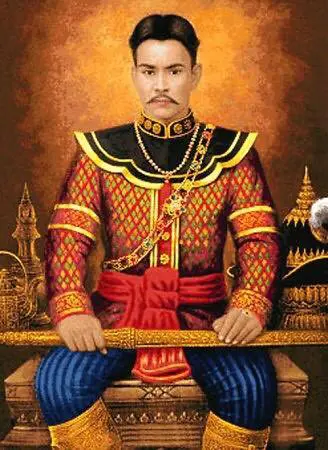
The right bank of the future Bangkok developed, driven by different communities, notably Portuguese, Chinese, as well as Muslims of Persian origin, who came to settle along the banks of the Chao Phraya. These communities, loyal to the king, had been allocated land not far from the palace of the time, for their contribution to the war effort.
Wat Arun
Many visit it, but few know that the temple was located within the grounds of the royal palace during the reign of Taksin, before his successor, Rama I, founded a new capital and moved the palace across the river. Indeed, the presence of a temple at this location has been proven since the 16th century. Taksin chose it to establish his palace and found his new capital, proceeding to restore what was then only a small local temple in a village known as Bang Makok.
Due to its function, it housed the famous Emerald Buddha between 1778 and 1784, which had just been seized at Vientiane (whose kingdom thus became a vassal of Siam). However, it was not Taksin who made it the iconic temple that we visit today. Because the attraction of Wat Arun, whose name is derived from the Hindu deity "Aruna", symbolizing the dawn, is this tower with an architecture that takes up the characteristics of ancient Khmer temples. In this case, we speak of a prang rather than a chedi but the function remains the same, to house a sacred relic.
This tower is the initiative of King Rama II, 2nd sovereign to reign over the new capital just opposite, Bangkok, then known as Rattanakosin. Rama II undertook a series of important works from 1792, rebuilding the temple and including the addition of this prang. These works were completed under his successor, Rama III, giving the temple its current appearance. The particularity of Wat Arun lies in the decoration of the main tower, using pieces of Chinese porcelain.

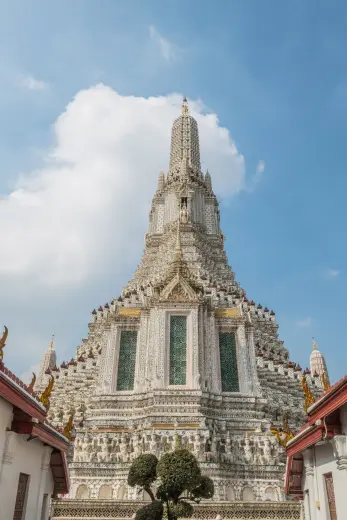
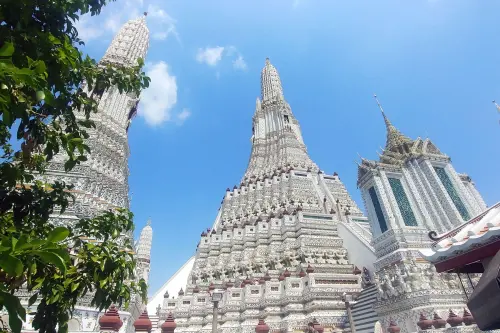


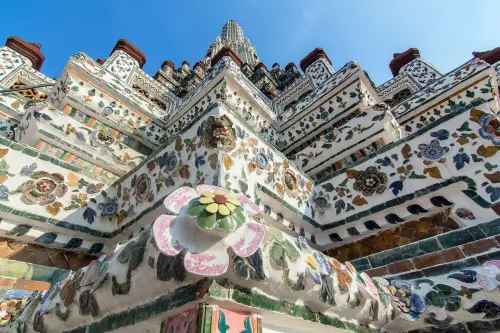


The rest of the temple is also interesting to visit. The main ubosot (or ordination hall), surrounded by a cloister housing a set of aligned Buddha statues, has, as is often the case, beautiful wall paintings. In this building, you will surely see a monk, ready to collect donations from the faithful but also available to bless you, then putting a small bracelet on your wrist.
As an aside, the old royal palace still stands next to Wat Arun. You can see a discreet red roof as you climb the sides of the tower, a building bordering the Chao Phraya. It is now used by the Royal Thai Navy.

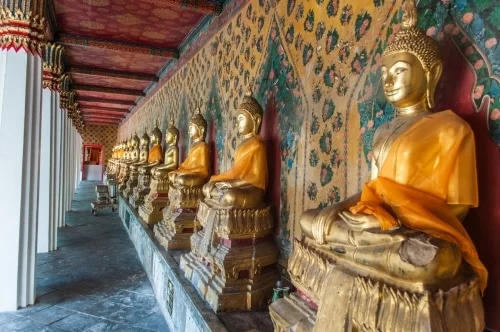


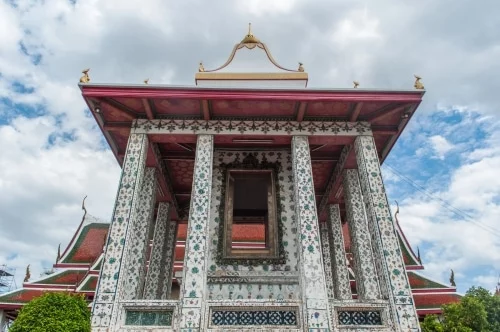
The Royal Barges Museum
I haven't visited it yet, but it's located not far from Phra Pin Klao Bridge, opposite Siriraj Hospital. It's often offered and included in a Bangkok canal tour (excluding entrance fee).
The barges are used for calendar processions marking events specific to the royal family AND a religious ceremony, called Kathin. Kathin is an important religious ceremony where many worshipers, including the royal family, donate new robes for the monks. Associated milestones could be, for example, years celebrating a new cycle of the king's reign or an anniversary year with a round number. Since I moved to Thailand, this event has only happened twice, which shows how rare it is.
The first time was in 2012, after a postponement, because the procession was supposed to take place at the end of October 2011, but there were major floods in Bangkok and throughout the country that year. This procession was organized to mark the 7th cycle of the reign of the late His Majesty Bhumibol Adulyadej (Rama IX), knowing that a cycle is based on the Chinese lunar calendar and therefore has 12 years.
The last procession dates back to 2019. It completed the coronation of the new king (Rama X), also celebrating the Kathin ceremony at Wat Arun.
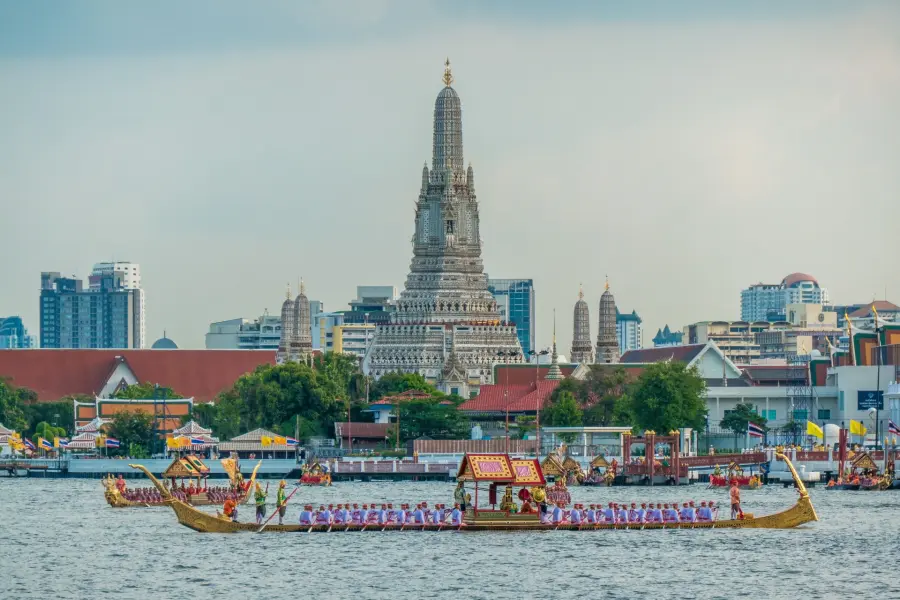
The museum is quite basic in itself. You can admire the 8 main barges out of the 52 that make up the fleet in total. In addition, out of the 52 barges, 51 are called "historical" (older) when the most important, the royal barge Narai Song Suban, was built more recently in 1994 under the reign of Rama IX. The lengths of the vessels vary between 28 and 46 meters. They are richly decorated and have in common a mouth of Naga, the mythological serpent, as a prow.
Apart from these 8 barges stored there, there are some objects and photos in the window, relating to this occasion.

Thonburi Old Train Station and Market
Few people know this, apart from those who use it of course, but Bangkok has several train stations (not counting secondary stops such as Samsen or Bang Sue to name a few). Indeed, in addition to the main station of Hua Lamphong, which celebrated its 100th anniversary this year, there was Thonburi.
Thonburi Station mainly serves destinations west of Bangkok such as Ratchaburi or Kanchanaburi as originally it was the main station to travel to the south of Thailand, before a connection was made further north of Bangkok, making Hua Lampong the real train hub in the capital.
And in terms of visiting, I am talking here above all about the old station, known as Bangkok Noi Railway Station. The latter was in operation between 1903 (built during the reign of Rama V) until 2003, when the last trains ran to this terminus.
In reality, the station still exists but it was moved about a kilometer to the west, to replace the terminus. The latter was to make way for new modern buildings as part of the expansion of the Siriraj Hospital (the same one where Rama IX died in 2016), adjacent to the station. The old station was preserved and its surroundings were then redeveloped with a park, parking and service areas.
Opposite the new Thonburi train station is a market, the Rot Fai Thonburi Market. There are lots of fruits and vegetables as well as various food products, many of which come here to stock up before boarding the train.
Baan Bu, the last bronze artisans
The name simply comes from the sound heard as the craftsmen hammer the bronze plates to give thickness to the utensils. Here, you will find a house open for visits, one of only two remaining active in this once bustling neighborhood. Nowadays, objects are made to order, they make unique pieces in bronze, especially religious objects like the bowls of the monks receiving alms.
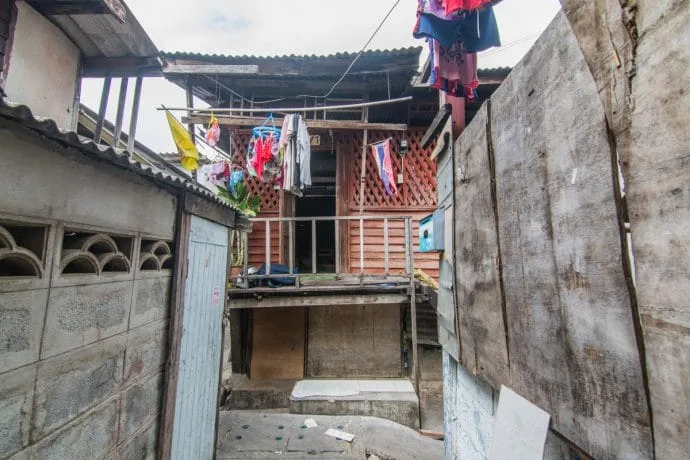
The technique has remained almost unchanged for 200 years, if we ignore the electrified tools used for polishing and which have replaced the stones. In addition to the workshop, you can see exhibition pieces that give a good idea of the fineness of the details once the product is finished. There is very little stock but if available, note that this is where you can buy pieces, it can make a unique souvenir.
Manufacturing process
Bronze is an alloy of copper and tin. These two elements are mixed to obtain sheets that will serve as raw material. These sheets are then heated in a charcoal fire and hammered several times by two people in turn until the desired shape is obtained.
The next step is grinding to bring back the shine of the bronze, blackened by the fire assembly process. The last step is polishing the surface of the bowl (or other) to refine the grinding. The bowls and trays can then be finished in the form of punched engravings.

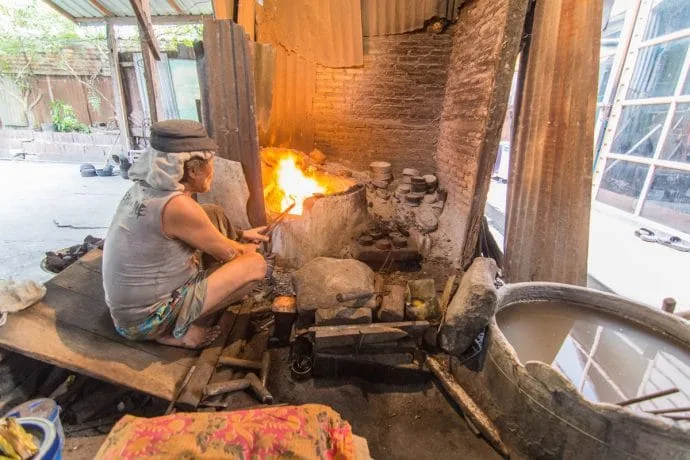
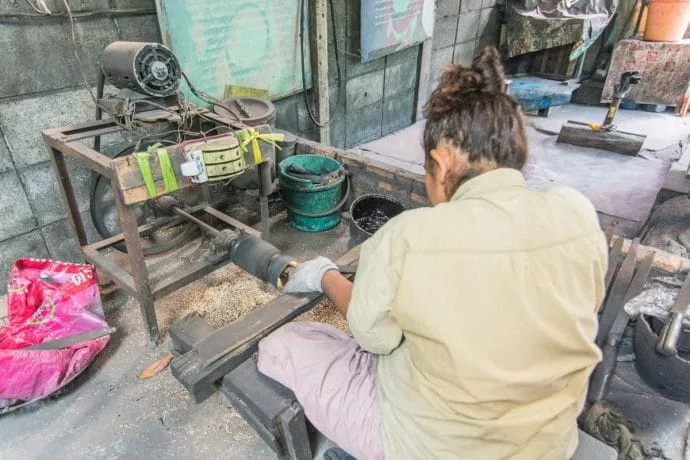
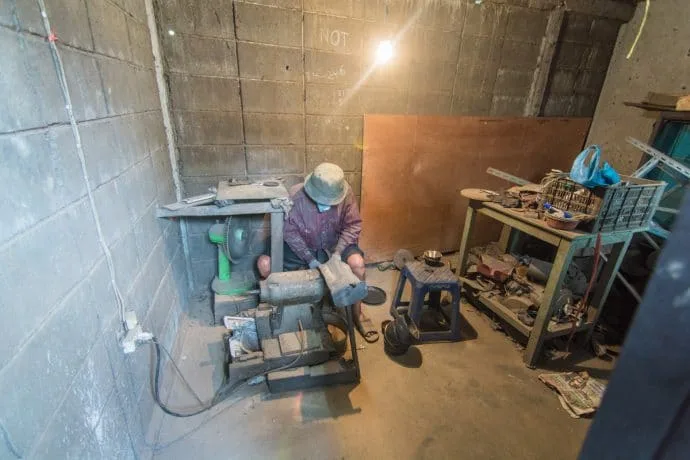
An activity that will disappear…
Already damaged by a major fire that ravaged the community 10 years ago, the bronze factory has been able to recover, but this is probably the last generation to run the workshop.
It is a long and difficult process, because the heat is obviously even higher than the ambient air, which is already very hot and humid all year round. A laborious and tedious task that certainly does not make the new generations dream. It is therefore an activity in decline, despite support, such as the royal family itself, who have already visited the premises and bought pieces from this historic workshop.

Wat Prayoon
At the very south of Kudee Jin, which I will tell you about below, practically at the foot of the Memorial Bridge (the first bridge in Bangkok), there is another temple. Its full name is Wat Prayoonwongsawat (or even Prayurawongsawas Waraviharn Temple on Google Maps), shortened to Wat Prayoon, it is a temple I visited for the first time on my way to an ordination ceremony, a student in Jitima who was becoming a monk temporarily, knowing that this is a mandatory passage for any man in Thailand).
It was built during the reign of King Rama III around 1828. You can immediately notice its large white chedi which reaches 60 m (the famous inverted bell shape, the generic name for a chedi being a pagoda). If you are curious, go through the door of the small air-conditioned museum filled with a multitude of Buddha statuettes. In the middle of the throne room is a beautiful stone piece, in a seated position with a naga on its back, dating from the XNUMXth century. But the interest lies above all in the access to the interior of the chedi, a rare and somewhat interesting fact. You access the courtyard behind the museum which therefore adjoins the large pagoda and a series of a few steps takes you to the intermediate platform, allowing you to enjoy an overall view of the temple.





Another special feature of this temple is its small adjacent garden, with a pond home to many fish and turtles. Visitors can feed the turtles that bathe here via the fruit vendor next door, an activity generally enjoyed by children. In Buddhism, turtles are considered sacred animals and it is a way of doing a good deed.
In the middle of the pond, a small artificial "mountain" sits enthroned. The "turtle mountain" was built following a dream of the king involving melted candle wax... Hence this appearance with fake stone that seems softened.
Spread around, one can see "spirit houses" dedicated to members of the Bunnag family (a rich Thai noble family, of Persian origin).
Kudee Jin
An old Sino-Portuguese community, located next to Wat Kalayanamit, an important temple of 3rd royal rank, only separated from Wat Arun by a canal (the Bangkok Yai, one of the main ones used for canal rides, which I talk about below). This district is one of my favorites in Bangkok because it is a small haven of peace. In addition to the charming alleys, you will come across old houses, one of which houses a museum. Kudee Jin is also the origin of a delicacy, a local specialty called Kanom Kudee Jin, which can be literally translated as "Kudee Jin dessert". It is a legacy of the Portuguese dating back to the Ayutthaya period. It is a soft cake, made from eggs, sugar and wheat flour.
Only three local bakeries produce this unique dessert. The most famous is Thanusingha, but you can also find it for sale at the Kudee Jin Museum, where I like to stop for a coffee, in this universe that makes you forget that you are still in the tumultuous capital.




It is a multicultural district that demonstrates very well the varied aspects that can be found in Bangkok, which I strive to show is not just a noisy city, made of skyscrapers and a few historical temples. You can visit the Chinese sanctuary of Kian Un Keng, and a few meters further, you will be facing a Portuguese church, the Santa Cruz church. If you are curious, you can also visit a mosque, Bang Luang Mosque, which looks like a Thai temple from the outside.
But rather than rehashing what I've already written, I invite you to simply read the article I wrote on Kudee Jin, summarizing the whole point of taking a look there.
https://thailande-et-asie.com/kudee-jin-quartier-historique-bangkok
Wat Kalayanamit
I mentioned it just above, Wat Kalayanamit (sometimes written with an r at the end, but which remains silent), is a royal temple also initiated by King Rama III in the 1820s. The name means "good friend", or "true friend" because the land on which it was built was a gift from a relative of the king.
Its architecture is particular because it was influenced by the Chinese community of Kudee Jin, who participated in its construction (as for the Santa Cruz church). Its large viharn, the central building houses the statue of Buddha called " Luang Pho To » later renamed « Trai Rattanayok » by King Rama IV. In a seated position, the latter is quite imposing with its 16 m high and 12 m wide, the whole being entirely covered in gold leaf.
Among the other peculiarities of this temple, which borders the Chao Phraya, we note the presence of the largest bronze bell in the country, which, according to belief, will bring you luck and happiness by ringing it 3 times.









Bangkok Canal Cruise
When you hear that you need to do a Bangkok canal cruise, this mainly refers to the canals on the Thonburi side. Most of the long tail boats (the famous long tail boats that you see everywhere on the river) make a loop first taking the canal called Bangkok Noi, before joining the Bangkok Yai (or vice versa). This tour on the canals, which once earned Bangkok the nickname of Venice of the East, allows you to see a different side of the capital and a glimpse of life, in the past.
There are still a good number of wooden houses on stilts, a vestige of a time when up to half of Bangkok's population lived along these waterways. It is also possible to stop and visit some temples lost in the meanders of this part of the city, where the favorite activity often consists of feeding the many catfish basking nearby. Another possibility is to go to an orchid farm, to admire the great varieties and colors of its magnificent flowers.
Finally, you can also stop at one of the city's floating markets if you are there on a weekend, such as Taling Chan or my favorite, the Lat Mayom floating market. But all this takes us a little away from the subject, because it is further away from Thonburi itself. To learn more about the walks along the khlongs of Bangkok, I will of course concoct a small complete article on the subject to know where to take a boat and know the prices and possibilities of visits. What you have to remember is that it happens on the Thonburi side, because the rare navigable canals on the other side of Bangkok are only dedicated to public transport and not to tourism.



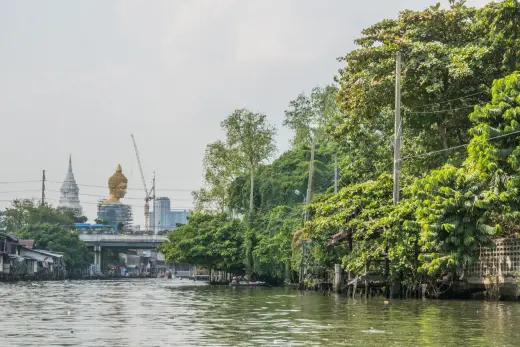


The Artist House
We are continuing with the canal walks because it is a visit that can also be done during this excursion. It is a little out of the way compared to the other places presented so far but I can't resist telling you about it. The Artist House, or, in good French, the house of artists is an old wooden house that offered daily (except Wednesdays) until recently, traditional Thai puppet shows. I am writing in the past tense because going there regularly, I noticed that the performances, normally taking place at 14 p.m., were becoming rarer.
The place remains interesting and the show, which now only takes place on weekends, is free. In addition, the neighborhood surrounding it is pleasant. For more details, I have also already written a full article on this house known to Thais as Baan Silapin.
Old Chinatown
What I call old Chinatown is the area almost opposite the current Chinatown, centered around Yaowarat Avenue. It is an area adjacent to the Memorial Bridge, on the other side of the Wat Prayoon I mentioned above. It includes streets where you can see a peaceful local life, vestiges of a richer past (many wealthy people building their homes and living along the river).
There is a mosque there, and a little further, a Chinese temple. There is also a small park that has its charm, the Princess Mother Memorial Park. It is a small park dedicated to the princess mother (queen of the previous king and therefore grandmother of the current king, Rama X) which was set up 20 years ago. There is a small museum, ruins of old buildings and a reproduction of the childhood home of the princess mother.









How to get to Thonburi
There is currently no metro going this way, but the good news is that it is under construction and will come.
The easiest way to get there so far is by ferry to Wat Arun, from Tha Tien Pier, opposite Wat Pho.
Other possible platforms are from Tha Chang, which crosses to Wat Rakangkositaram Woramahavihan, and a little further, another platform, Tha Phrachan Color Lab, joins Siriraj Hospital.
Further south, it is possible to cross via the quay at the end of the Yopdiman River Walk, located behind the flower market, which joins Wat Kalayanamit. Also possible from Ratchawong quay, towards Chinatown.
Finally, on foot; you can simply either take the Memorial Bridge, also close to the flower market, or the Phra Pin Klao Bridge, which is located between Khao San Road and the royal square of Sanam Luang.
Thonburi on a map
Did you like the article? share on Pinterest!



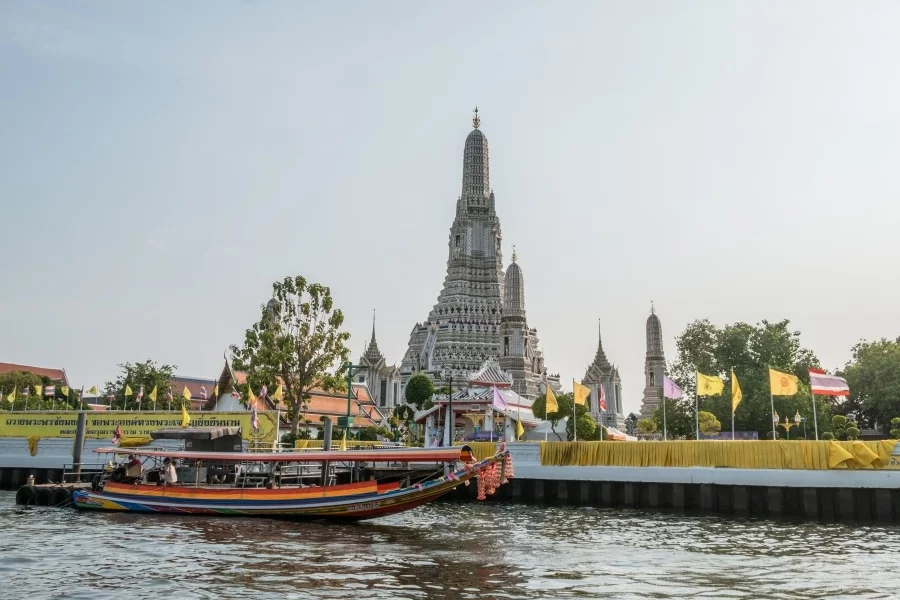





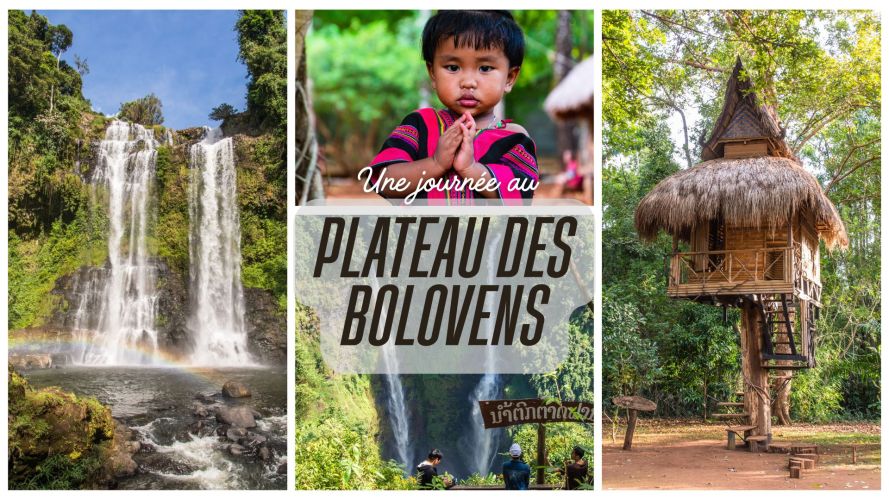
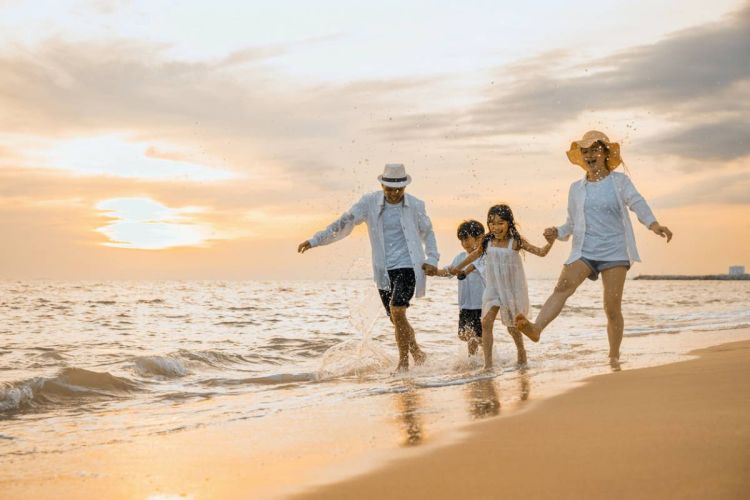
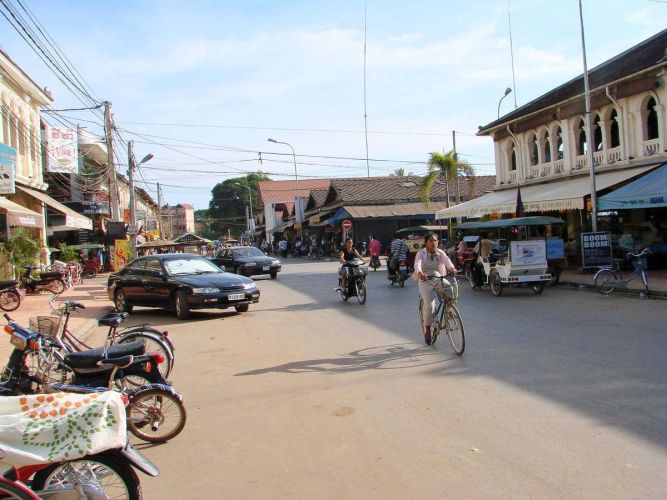
4 Comments
Thonburi is on the RIGHT bank of the Chao Phraya! The Grand Palace, for example, is on the LEFT bank. You stand on the river, facing its mouth, to determine the left/right bank.
Hello,
Thanks for reminding me of this mistake, I found out about it after writing this article and had forgotten to correct it since then... now it's done 😉
Hello,
December, is it hot and dry in Bangkok? Is it easy for a foreigner to visit this area? Are the people friendly in this area?? I have already visited Phuket and Chang mai. But I could not visit Thonburi, lack of time, because I was only two days in Bangkok. Thank you for your answer.
Hello,
This is what we call "winter" here, so in summary yes, it is always warm (even if not extreme) and drier indeed. It is absolutely no more difficult than elsewhere in the city, the main thing is to be curious. There is no reason why they should not be friendly, you are in the land of smiles after all 😉 A bad welcome is very rare (it happened to me two or three times in isolated mountain villages but that's about it).